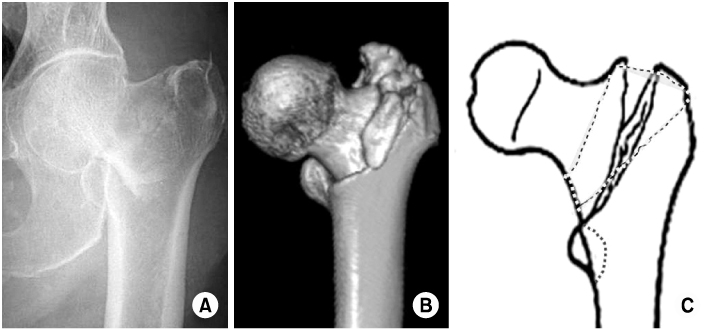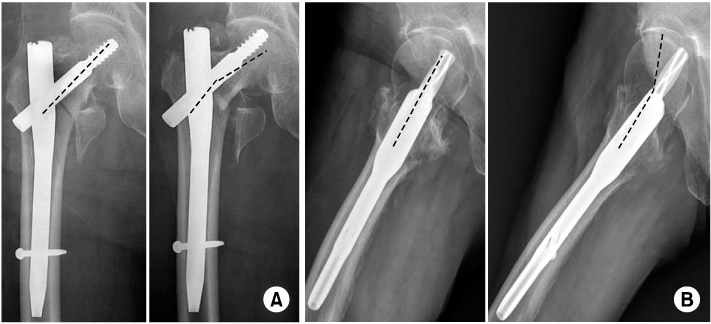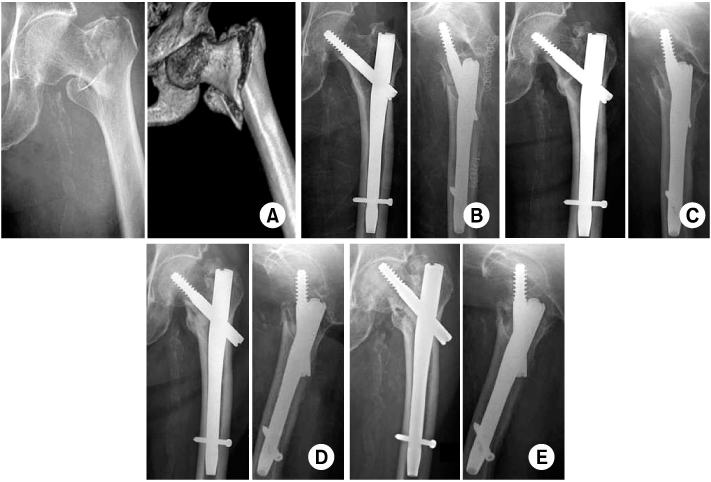J Korean Fract Soc.
2012 Jul;25(3):169-176.
Analysis of the Fixation Failure in Intertrochanteric Hip Fractures Treated with Hip Nailing
- Affiliations
-
- 1Department of Orthopedic Surgery, Hallym University College of Medicine, Seoul, Korea. oships@hallym.ac.kr
Abstract
- PURPOSE
To analyze the patterns of and risk factors for fixation failure after hip nailing in intertrochanteric (IT) hip fractures.
MATERIALS AND METHODS
Fourteen patients who sustained a fixation failure after hip nailing for IT hip fractures were enrolled in this study. The mean age at the index surgery was 74.5 years and the mean time to the fixation failure was 6.6 weeks. All of the serial radiographs up to the fixation failure and pre-operative 3-D computed tomography were analyzed.
RESULTS
According to AO classification, there were 7 stable fractures and 7 unstable ones. Of the total of 14 cases, 10 showed a comminution of the greater trochanter tip and incomplete anatomical reduction of the medial and anterior cortex at the fracture site. Of the 10 cases with appropriate position of the lag screw within the femoral head, 9 showed a high pertrochanteric fracture (HPF) pattern. The mechanism of the fixation failure was rotation of the femoral head in 7 of 9 cases with HPF and varus collapse of the proximal fragment in 4 of the other 5 cases.
CONCLUSION
The HPF pattern, the comminution of the greater trochanter tip, and incomplete reduction of the medial and anterior cortex may be additional risk factors of fixation failure after treating IT hip fractures with hip nailing in.
Keyword
Figure
Reference
-
1. Baumgaertner MR, Curtin SL, Lindskog DM. Intramedullary versus extramedullary fixation for the treatment of intertrochanteric hip fractures. Clin Orthop Relat Res. 1998. (348):87–94.
Article2. Bojan A, Taglang G, Beimel C, Jonsson A, Schnettler R. A retrospective analysis of cut out complication in 3066 patients treated with Gamma nails. J Orthop Trauma. 2004. 18:S21.3. Boriani S, Bettelli G, Zmerly H, et al. Results of the multicentric Italian experience on the Gamma nail: a report on 648 cases. Orthopedics. 1991. 14:1307–1314.
Article4. Bridle SH, Patel AD, Bircher M, Calvert PT. Fixation of intertrochanteric fractures of the femur. A randomised prospective comparison of the gamma nail and the dynamic hip screw. J Bone Joint Surg Br. 1991. 73:330–334.
Article5. Brink PR, Bolhuis RJ, Runne WC, De Vries AC. Low nail-plate fixation and early weight-bearing ambulation for stable trochanteric fractures. J Trauma. 1987. 27:491–495.
Article6. Butt MS, Krikler SJ, Nafie S, Ali MS. Comparison of dynamic hip screw and gamma nail: a prospective, randomized, controlled trial. Injury. 1995. 26:615–618.
Article7. Carr JB. The anterior and medial reduction of intertrochanteric fractures: a simple method to obtain a stable reduction. J Orthop Trauma. 2007. 21:485–489.
Article8. Davis J, Harris MB, Duval M, D'Ambrosia R. Pertrochanteric fractures treated with the Gamma nail: technique and report of early results. Orthopedics. 1991. 14:939–942.
Article9. Davis TR, Sher JL, Horsman A, Simpson M, Porter BB, Checketts RG. Intertrochanteric femoral fractures. Mechanical failure after internal fixation. J Bone Joint Surg Br. 1990. 72:26–31.
Article10. Den Hartog BD, Bartal E, Cooke F. Treatment of the unstable intertrochanteric fracture. Effect of the placement of the screw, its angle of insertion, and osteotomy. J Bone Joint Surg Am. 1991. 73:726–733.
Article11. Doherty JH Jr, Lyden JP. Intertrochanteric fractures of the hip treated with the hip compression screw: analysis of problems. Clin Orthop Relat Res. 1979. (141):184–187.12. Fogagnolo F, Kfuri M Jr, Paccola CAJ. Intramedullary fixation of pertrochanteric fractures with the short AO-ASIF proximal femoral nail. Arch Orthop Trauma Surg. 2004. 124:31–37.
Article13. Geller JA, Saifi C, Morrison TA, Macaulay W. Tip-apex distance of intramedullary devices as a predictor of cut-out failure in the treatment of peritrochanteric elderly hip fractures. Int Orthop. 2010. 34:719–722.
Article14. Goldhagen PR, O'Connor DR, Schwarze D, Schwartz E. A prospective comparative study of the compression hip screw and the gamma nail. J Orthop Trauma. 1994. 8:367–372.
Article15. Halder SC. The Gamma nail for peritrochanteric fractures. J Bone Joint Surg Br. 1992. 74:340–344.
Article16. Johnell O, Kanis JA. An estimate of the worldwide prevalence, mortality and disability associated with hip fracture. Osteoporos Int. 2004. 15:897–902.
Article17. Kawaguchi S, Sawada K, Nabeta Y. Cutting-out of the lag screw after internal fixation with the Asiatic gamma nail. Injury. 1998. 29:47–53.
Article18. Kim WY, Han CH, Park JI, Kim JY. Failure of intertrochanteric fracture fixation with a dynamic hip screw in relation to pre-operative fracture stability and osteoporosis. Int Orthop. 2001. 25:360–362.
Article19. Kyle RF, Gustilo RB, Premer RF. Analysis of six hundred and twenty-two intertrochanteric hip fractures. J Bone Joint Surg Am. 1979. 61:216–221.
Article20. Larsson S, Friberg S, Hansson LI. Trochanteric fractures. Influence of reduction and implant position on impaction and complications. Clin Orthop Relat Res. 1990. (259):130–139.21. Laskin RS, Gruber MA, Zimmerman AJ. Intertrochanteric fractures of the hip in the elderly: a retrospective analysis of 236 cases. Clin Orthop Relat Res. 1979. (141):188–195.22. Leung KS, So WS, Shen WY, Hui PW. Gamma nails and dynamic hip screws for peritrochanteric fractures. A randomised prospective study in elderly patients. J Bone Joint Surg Br. 1992. 74:345–351.
Article23. Lindsey RW, Teal P, Probe RA, Rhoads D, Davenport S, Schauder K. Early experience with the gamma interlocking nail for peritrochanteric fractures of the proximal femur. J Trauma. 1991. 31:1649–1658.
Article24. Liu M, Yang Z, Pei F, Huang F, Chen S, Xiang Z. A meta-analysis of the Gamma nail and dynamic hip screw in treating peritrochanteric fractures. Int Orthop. 2010. 34:323–328.
Article25. Mahomed N, Harrington I, Kellam J, Maistrelli G, Hearn T, Vroemen J. Biomechanical analysis of the Gamma nail and sliding hip screw. Clin Orthop Relat Res. 1994. (304):280–288.
Article26. Mainds CC, Newman RJ. Implant failures in patients with proximal fractures of the femur treated with a sliding screw device. Injury. 1989. 20:98–100.
Article27. Mulholland RC, Gunn DR. Sliding screw plate fixation of intertrochanteric femoral fractures. J Trauma. 1972. 12:581–591.
Article28. Nishiura T, Nozawa M, Morio H. The new technique of precise insertion of lag screw in an operative treatment of trochanteric femoral fractures with a short intramedullary nail. Injury. 2009. 40:1077–1083.
Article29. Parker MJ. Cutting-out of the dynamic hip screw related to its position. J Bone Joint Surg Br. 1992. 74:625.
Article30. Radford PJ, Needoff M, Webb JK. A prospective randomised comparison of the dynamic hip screw and the gamma locking nail. J Bone Joint Surg Br. 1993. 75:789–793.
Article31. Sernbo I, Johnell O, Gentz CF, Nilsson JA. Unstable intertrochanteric fractures of the hip. Treatment with Ender pins compared with a compression hip-screw. J Bone Joint Surg Am. 1988. 70:1297–1303.
Article32. Sommers MB, Roth C, Hall H, et al. A laboratory model to evaluate cutout resistance of implants for pertrochanteric fracture fixation. J Orthop Trauma. 2004. 18:361–368.
Article33. Utrilla AL, Reig JS, Muñoz FM, Tufanisco CB. Trochanteric gamma nail and compression hip screw for trochanteric fractures: a randomized, prospective, comparative study in 210 elderly patients with a new design of the gamma nail. J Orthop Trauma. 2005. 19:229–233.
Article34. Wu CC, Shih CH, Lee MY, Tai CL. Biomechanical analysis of location of lag screw of a dynamic hip screw in treatment of unstable intertrochanteric fracture. J Trauma. 1996. 41:699–702.
Article35. Yoshimine F, Latta LL, Milne EL. Sliding characteristics of compression hip screws in the intertrochanteric fracture: a clinical study. J Orthop Trauma. 1993. 7:348–353.
Article
- Full Text Links
- Actions
-
Cited
- CITED
-
- Close
- Share
- Similar articles
-
- The Value of the Tip - Apex Distance in Predicting Failure of Fixation of Intertrochanteric Fractures of the Hip
- Fixation Failure after internal Fixation in Intertrochanteric Fractures
- External Fixation Under Local Anesthesia in Intertrochanteric Fracture Patients with High Anesthetic Risk: 3 Case Reports
- Risk Factors Associated with Fixation Failure in Intertrochanteric Fracture Treated with Cephalomedullary Nail
- Blade Plate Fixation for Failed Internal Fixation of Intertrochanteric Hip fractures




